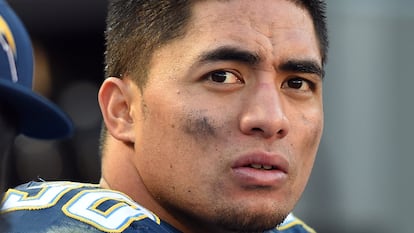The football star and the dead girlfriend who never existed
‘Untold: The Girlfriend Who Didn’t Exist’ brings together Manti Te’o and the person who made him fall for a fake online relationship that became the butt of an international joke
It was the beginning of the last decade, and Hawaiian Manti Te’o was the star of the Notre Dame Fighting Irish, the historic football team from Indiana. Sports Illustrated had even named him its “physical and emotional center” in a passionate article that also highlighted the delicate and sensitive moment that the athlete was going through in October 2012: his beloved grandmother and his girlfriend had passed away just six hours apart.
Te’o had been in a relationship with a woman named Lennay Kekua, an attractive Hawaiian with slanted eyes, for almost a year, although most of that time she had been hospitalized due to a serious car accident. Then, just a couple of months later, she had been diagnosed with leukemia. He lived in Indiana and she in California, but they spoke on the phone every day. She was his main support; he kept her company through her illness. “Her relatives told him that at her lowest points, as she fought to emerge from a coma, her breathing rate would increase at the sound of his voice,” published the magazine.
After her death, the Notre Dame fans flocked to the field wearing leis, the traditional Hawaiian garland. That day, Te’o played his best game and dedicated it to her. He did not attend the funeral because, he said, all she wanted was for him to send some white roses.
Nominated for the year’s most important awards and responsible for Notre Dame’s best season in decades, Te’o was also a devout Mormon, committed to his family. His image, so far removed from the usual excesses of the college stars, made the sponsors rub their hands. But then, the sports website Deadspin received an anonymous email and all hell broke loose.

A fake death to avoid ridicule
“While Manti Te’o is a loved native son here in Hawaii he is also a fraud. The story about his girlfriend dying is completely made up. The story floating around the island is this: Manti was duped by a man online pretending to be this girl, Lennay Kekua. Once Manti found out he had been tricked he made up the story that she died in order to ensure that no one asked questions and he never looked foolish,” read the message.
Reporters Timothy Burke and Jack Dickey began to pull the thread and soon discovered that something was amiss. Lennay Kekua only seemed to exist in relation to Manti Te’o; there were no fingerprints and there was no information about her other than the player’s statements. The dates and the romantic details of their relationship also changed from one interview to another.
In January 2013, the website dropped the bombshell: “Manti Te’o’s Dead Girlfriend, The Most Heartbreaking And Inspirational Story Of The College Football Season, Is A Hoax.” The person that the player had been emotionally attached to for a year was actually Ronaiah Tuiasosopo, a former quarterback turned musician who performed regularly at a fundamentalist church and was part of the player’s circle of friends.
Manti Te’o had been catfished. The practice owes its name to the documentary Catfish, in which photographer Nev Schulman discovered – on camera – that the woman he had fallen in love with through Facebook was not a 19-year-old student, but a 40-year-old housewife, married and with children.
To give credibility to the character, Ronaiah Tuiasosopo used the photo of a real woman: Diane O’Meara, a friend from school who was completely oblivious to the fraudulent romance. Tuiasosopo used it to create Instagram, Twitter and Facebook profiles to gain access the object of his devotion. He was also helped by two friends who communicated with Te’o, posing as relatives of Lennay.

A very public affair
All the media echoed the scandal, as well as the obvious question: if Lennay Kekua was an invention, but Te’o had claimed in several interviews to have met her, was he in on it? Had it all been a ruse to increase his popularity? The truth was sadder than that. According to him, he did it because of the embarrassment of admitting that he had fallen in love with a woman he had never seen.
Three weeks before the article was published, Te’o had confessed to his parents that his girlfriend, whom he believed had been dead for months, had called him to let him know that she was alive; she had actually faked her death in order to fool some drug dealers who wanted to kill her. His parents contacted agent Tom Condon so that, together with the University of Notre Dame, he could make up a plan to protect the image of the player. But it was too late. After Deadspin’s publication, Te’o confessed all the details of the fake relationship.
Tuiasosopo himself confessed the truth on the Dr. Phil show: he was deeply and romantically in love with Te’o. “After everything I had gone through I finally realized that I just had to move on with my life.” He added: “I had to start just living and let this go. There were many times when Manti and Lennay had broken up, but something would bring them back together, whether it was something going on in his life, or in Lennay’s life – in this case, in my life.” To show the mechanics of his scheme, he even spoke with the female voice that had charmed Te’o.

Manti Te’o’s life fell apart. He went home, got into bed and tried to deal with things. Still, when he went out he could tell that people looked at him. He could hear them whispering, he told ABC. And the fact that the relationship had been an illusion did nothing to ease the pain. Even if nothing had been real, his feelings still were.
In the end, Tuiasosopo finally contacted Te’o as himself. However, even though he confessed and apologized, nothing he could say would fix the situation, Te’o said to ABC. Tuiasosopo’s relatives, on the other hand, believe that Te’o knew more than he admits. “How dense would Manti Te’o have to be to not realize this was his friend who was behind the account the entire time?” his uncle asked. “I don’t believe Manti Te’o could be that dumb.”
One decade later, on August 16, Netflix will premiere Untold: The Girlfriend Who Didn’t Exist, a documentary that gives a voice to its two protagonists. In 2022 Manti Te’o does not have the sports career that his talent predicted, but he is a happily married man who seems to have found an emotional balance. Ronaiah Tuiasosopo is now Naya, a transgender woman who has overcome the doubts and fears that led to the creation of Lennay.
Tu suscripción se está usando en otro dispositivo
¿Quieres añadir otro usuario a tu suscripción?
Si continúas leyendo en este dispositivo, no se podrá leer en el otro.
FlechaTu suscripción se está usando en otro dispositivo y solo puedes acceder a EL PAÍS desde un dispositivo a la vez.
Si quieres compartir tu cuenta, cambia tu suscripción a la modalidad Premium, así podrás añadir otro usuario. Cada uno accederá con su propia cuenta de email, lo que os permitirá personalizar vuestra experiencia en EL PAÍS.
¿Tienes una suscripción de empresa? Accede aquí para contratar más cuentas.
En el caso de no saber quién está usando tu cuenta, te recomendamos cambiar tu contraseña aquí.
Si decides continuar compartiendo tu cuenta, este mensaje se mostrará en tu dispositivo y en el de la otra persona que está usando tu cuenta de forma indefinida, afectando a tu experiencia de lectura. Puedes consultar aquí los términos y condiciones de la suscripción digital.
Últimas noticias
Most viewed
- Sinaloa Cartel war is taking its toll on Los Chapitos
- Oona Chaplin: ‘I told James Cameron that I was living in a treehouse and starting a permaculture project with a friend’
- Reinhard Genzel, Nobel laureate in physics: ‘One-minute videos will never give you the truth’
- Why the price of coffee has skyrocketed: from Brazilian plantations to specialty coffee houses
- Silver prices are going crazy: This is what’s fueling the rally










































